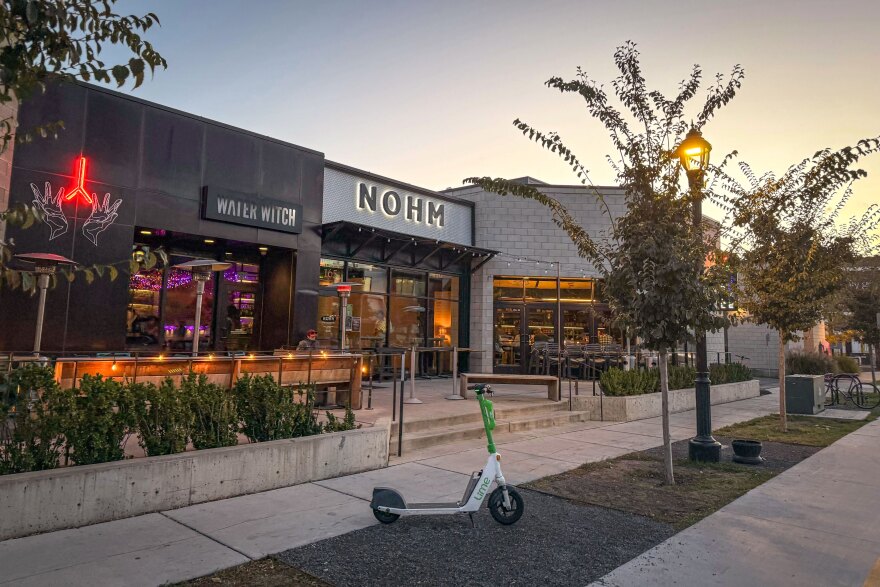The sounds of friendly chatter filled the air at Fisher Brewing, while indie rock artists like Wunderhorse and MJ Lenderman floated over the speakers. The big brick building is made up of wide, open rooms. But the big garage doors spanning the walls hint that it wasn’t always the lively bar it is today.
Just a decade ago, it was an old, empty auto shop in the heart of the Granary District, just southwest of Salt Lake’s Downtown. Colby Frazier, co-owner and the head brewer, said the cheap warehouse space is what drew them there.
“We definitely opened eight years ago because of what the Granary District was, not necessarily what it would become,” Frazier said.
The Granary District is one of Salt Lake’s oldest districts, historically known for manufacturing, processing and storing goods. In the last few years, that reputation has changed. The neighborhood has taken on a new identity as a cultural hub, home to local restaurants, bars, businesses, art and live music.
“Before this, it was really overlooked,” said Granary District Alliance board member and local muralist Josh Scheuerman. “We've tried to go back through history and redefine what we are and what we want to be.”

The Granary District has always had “grit” and that’s a part of their character they don’t want to lose.
“We all identified that we've always wanted to keep and rehab the buildings that are here, or keep the makers and place makers here, because they were here before it evolved,” Scheuerman said.
But like other Salt Lake City neighborhoods, the Granary District’s growth has also brought a choice: maintain its historic identity or give in to change.
Brandy Strand, executive director of Preservation Utah, said that question gets right to the heart of preservation.
“It's that sense of place, that thing that ties everyone together. I think of it almost as the heart or the core of a community in the neighborhood,” Strand said. “And when we start to lose those pieces, the identity of that community can also get lost in the development and the growth.”
Salt Lake City’s Japantown is a cautionary tale. In the 1960s, it spanned nearly 10 blocks with almost 8,000 residents. Today, just two of the community’s original structures remain, and its future is still uncertain.

Preservation doesn’t necessarily mean everything needs to be saved exactly as it is, Strand said. Some change is inevitable, especially since Utah’s most populated city keeps getting bigger.
“We need to grow and change with the world,” Strand said. “And we can find that balance if we're willing to have that difficult conversation, where we balance preservation with the need for growth.”
That’s a philosophy the Central Ninth Community Council has tried to keep front of mind through that neighborhood’s recent changes. Central Ninth is right next door to the Granary and a few years ahead in its development.
“You don't have to go back too far, 10-20 years ago, the neighborhood did look a lot different,” said Douglas Flagler, community council chair for Central Ninth.
Before then, there wasn’t much there, he said. The neighborhood wasn’t a destination, and people just came through on their way downtown. But today, it houses local gastronomy and businesses like the Central 9th Market. Since opening its doors in 2021, it’s become known for making one of Salt Lake City’s favorite breakfast sandwiches. And the district has gained attention since new infrastructure made the area more walkable and bikeable.
“It also had its own culture too,” Flagler said. “The neighborhood has been historically a mix of people from the LGBTQ community or underserved populations for a long time, and so there's been that identity in the neighborhood for a long time as well.”

Central Ninth is located on 900 S, also known as Harvey Milk Boulevard, a long-time home to LGBTQ-owned stores, bars and restaurants. Flagler said they’re mindful of these roots through their growth and they want to keep that diversity in the neighborhood.
“We really wanted to make it a space where people felt like their community was seen and heard, you know, and that the culture and the history that lives along that street is highlighted,” Flagler said.

As a neighborhood develops, identity isn’t the only thing on the line. In the Granary District, Colby Frazier said gentrification has taken away the things that drew Fisher Brewing there in the first place.
“It was an opportunity for us to open a business of our dreams in an affordable place,” he said of the neighborhood when they started. “And I'm not so sure that that exists anymore in the Granary District.”
It would be impossible for Fisher to do that same thing today, he said, but he hopes local businesses can keep coming to the area. As much as things have already changed, board director Josh Scheuerman said there’s still a lot in store.
“I'd say more than 60% of the granary is being developed, or planned to be developed,” Sheruerman said. “So what Granary District looks like now is going to be vastly different from what is going to exist in five years.”
That’s why it takes intentional effort, Preservation Utah’s Brandy Strand said, to keep an area’s character. Because a neighborhood doesn’t happen by accident.
“We really need to take into consideration, what are those pieces that matter a lot to those people who live and breathe there, and preserving and protecting those pieces, honoring that aspect of our history,” she said. “Then partnering with our community to say, we want to have a vibrant hub here, so we'll preserve these things, and then we can grow in ways that matter. That can then elevate that community even more.”
As Strand noted, once those things that matter are gone, you can’t get them back.





